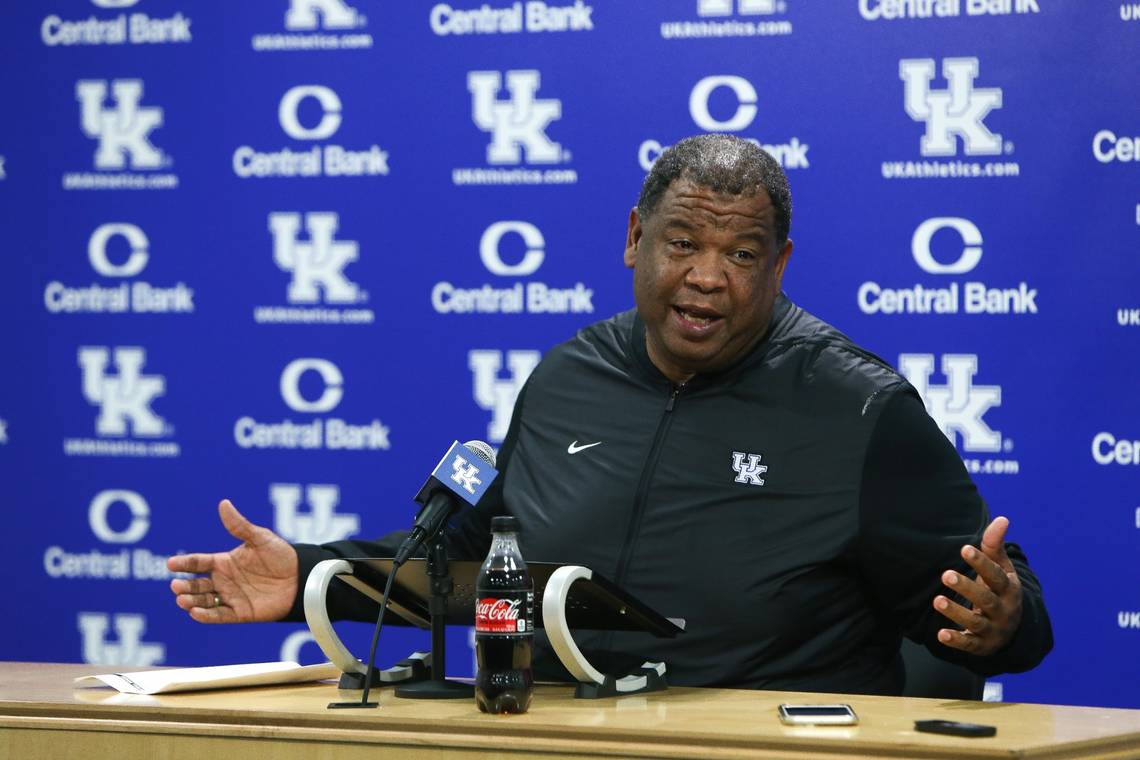When Vince Marrow made the shocking decision to leave the University of Kentucky for in-state rival Louisville, it sent a tremor through the college football landscape, especially in the Bluegrass. Marrow, affectionately known as the “Big Dog,” had been a cornerstone of Kentucky’s recruiting success, a larger-than-life figure whose loyalty to the Wildcats had become legend. So when he made the unexpected jump to the Cardinals, fans were stunned, critics swarmed, and all eyes turned to one man—Kentucky Athletic Director Mitch Barnhart.
For a man who’s often known for his calm, composed demeanor, Barnhart’s response was measured, but it carried unmistakable undertones of resolve. In a brief but impactful media session held just 48 hours after the announcement, Barnhart addressed the departure with a mixture of respect, disappointment, and confidence in the path forward.
“You never like to lose good people,” Barnhart began, his tone even but serious. “Vince has been a big part of what we’ve built here, and we’re grateful for what he brought to this program. That said, we’re not going backward.”
Those last five words echoed far beyond the press room. Kentucky football under Mark Stoops—and with Marrow as one of its chief architects—has grown from an SEC afterthought into a perennial contender, especially in recruiting. Marrow’s relationships across Ohio and the Midwest helped bring in talent that elevated Kentucky’s profile and on-field performance. His exit, particularly to a school that Kentucky fans view with deep-rooted rivalry, wasn’t just a staff change—it was a gut punch.
Still, Barnhart wasn’t interested in dramatics or blame. Instead, he struck a tone of continuity and progress, reminding fans and media that Kentucky football is bigger than any one individual.
“We have a culture here that’s built to last,” he continued. “It’s built on consistency, integrity, and a commitment to our student-athletes. That culture doesn’t vanish because one person decides to take another opportunity.”
In many ways, Barnhart’s statement served dual purposes. It honored Marrow’s contributions—nine years of recruiting battles, player development, and emotional investment—but it also sent a clear message: Kentucky is moving forward, and it’s doing so with confidence.
Still, there’s no denying the impact of the departure. Marrow was more than just a tight ends coach or associate head coach. He was a voice in the locker room, a presence on the sidelines, and an ambassador for the program off the field. Recruits didn’t just come to Kentucky because of the facilities or the brand—they came because they believed in the staff, and no one embodied that staff’s charisma quite like Marrow.
Yet Barnhart’s steadiness in the face of that loss speaks volumes about the maturity of the Kentucky program. In his nearly two-decade tenure as athletic director, he’s seen his fair share of highs and lows—from hiring Mark Stoops and John Calipari, to overseeing massive facilities upgrades, to navigating coaching changes and NCAA reforms. His ability to weather change has been key to the department’s growth, and this moment was no different.
When asked whether he was surprised by Marrow’s move, Barnhart paused before choosing his words carefully.
“In this business, you learn never to be too surprised,” he said. “Opportunities come up. People make decisions based on what’s best for them and their families. All you can do is thank them for their time here and keep moving forward.”
Behind the scenes, sources within the Kentucky athletic department confirmed that Barnhart and Stoops had known about the potential departure for several days. Though the timing wasn’t ideal—squarely in the heart of recruiting season—the coaching staff had already begun laying contingency plans. Kentucky has long been lauded for its strong support staff and recruiting infrastructure, and that stability may prove critical in ensuring continuity during the transition.
Barnhart was quick to emphasize that Stoops remains at the center of the program’s identity, and that the blueprint for success remains intact.
“Mark is the leader of this program,” Barnhart said. “He’s built something special here, and I have complete trust in his ability to keep us on that upward path. One coach doesn’t define who we are.”
Indeed, Stoops and Barnhart have forged a rare alliance in college football—a head coach and athletic director who have worked hand-in-hand for over a decade. Their shared vision and mutual respect have been the foundation of Kentucky’s football renaissance. And even with Marrow’s departure, that foundation appears solid.
Fans, of course, had their own reactions. Social media exploded with a mix of disbelief, frustration, and gratitude. Some questioned how the university allowed such a vital piece of its football machine to walk out the door. Others thanked Marrow for his years of service and wished him well—before immediately circling the date of the next Louisville-Kentucky showdown.
Barnhart seemed aware of the emotional weight behind those reactions, but again urged perspective.
“Fans are passionate, and we love that,” he said. “But this is a long journey. One move—no matter how high-profile—doesn’t undo what we’ve built. Our goals haven’t changed.”
What has changed, however, is the dynamic of the Kentucky-Louisville rivalry. With Marrow now wearing red and black, there will be no shortage of drama when the two teams meet. The recruiting battles will intensify. The media narratives will explode. And for Barnhart, the challenge will be ensuring Kentucky doesn’t lose momentum amid the noise.
If his track record is any indication, that won’t be a problem.
Mitch Barnhart is no stranger to adversity. He’s led Kentucky athletics through periods of transformation, criticism, and triumph. He’s hired coaches who’ve changed the face of their sports. He’s balanced budgets, upgraded facilities, and elevated expectations across the board. And through it all, he’s remained a figure of quiet consistency—a leader who doesn’t need headlines to make impact.
In many ways, his response to the Marrow situation was vintage Barnhart: low-key, steady, and focused on the future.
“We’ll be just fine,” he said in closing. “This program is bigger than any one person. And we’re going to keep building something our fans can be proud of.”
That message won’t erase the sting of losing a beloved assistant to a rival, but it might just be the steady hand Kentucky needs as it charts its next chapter. Because if there’s one thing Barnhart made clear, it’s this: Kentucky football isn’t going anywhere. Not now. Not ever.
And when that next Louisville game rolls around, you can bet Mitch Barnhart will be watching closely—not just as an athletic director, but as the guardian of a program that has weathered storms before and come out stronger every time.



